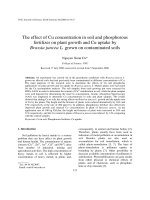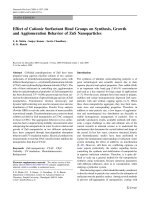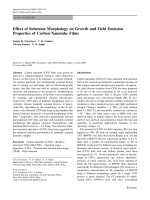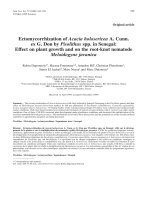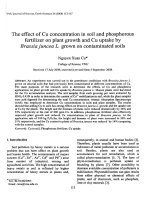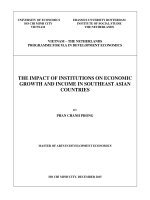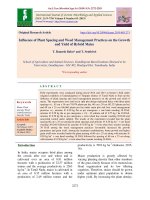Effect of mycorrhizal application on plant growth and nutrient uptake of piper mullesua plantlets under sterilized, unsterilized and field soil condition
Bạn đang xem bản rút gọn của tài liệu. Xem và tải ngay bản đầy đủ của tài liệu tại đây (371.07 KB, 13 trang )
Int.J.Curr.Microbiol.App.Sci (2020) 9(5): 2948-2960
International Journal of Current Microbiology and Applied Sciences
ISSN: 2319-7706 Volume 9 Number 5 (2020)
Journal homepage:
Original Research Article
/>
Effect of Mycorrhizal Application on Plant Growth and Nutrient
Uptake of Piper mullesua Plantlets under Sterilized, Unsterilized
and Field Soil Condition
Arundhati Bordoloi1* and A. K. Shukla2
1
Krishi Vigyan Kendra, Sivasagar, Assam Agricultural University, India
2
Indira Gandhi National Tribal University, Amarkantak, MP, India
*Corresponding author
ABSTRACT
Keywords
Mycorrhizal fungi,
Sterilized soil,
Piper mullesua,
Plant biomass and
phosphatase
Article Info
Accepted:
23 April 2020
Available Online:
10 May 2020
Mycorrhizal fungi occur in most of the soils and colonize roots of many plant species. A greenhouse experiment
was carried out to study the efficiency of Arbuscular Mycorrhizal fungi indigenous to Arunachal Pradesh in
uptaking plant nutrients for the Piper mullesua plantlets at different soil condition i.e., sterilized soil, unsterilized
soil and field condition. As the sterilized soil condition is difficult to understand the performance of AM fungi,
field experiments are necessary to understand the effect of mycorrhizal fungi on yield of crops in field condition.
The experiment was done to determine the effectiveness of mycorrhizal fungal inoculated with P. mullesua
plantlets assessing its effect on plant growth and plant nutrition when compared with non-mycorrhizal P.
mullesua plantlets in sterilized, unsterilized and field condition. For this ten different mycorrhizal fungal species
isolated from various land use systems such as forest area, jhum fields, home gardens as well as natural habitat of
piper plants were inoculated with the plantlets of P. mullesua in three different set of experiment. In present study
G. claroidium (2.238gm ±0.209), G. aggregatum (2.122gm ±0.057) and G. versiforme (2.109gm ±0.051) were
found more capable in producing better growth by infecting Piper mullesua plantlets under field soil as
compared to unsterilized and sterilized soil condition. Plant phosphatase content was significantly (p>0.001)
higher in the seedlings grown in unsterilized soil, followed by in field condition and least in the sterilized soil.
These inocula were efficient in establishing beneficial relationship with other native microorganisms of soil. As
chemical fertilizers possess threat to the environment by polluting soil and environment, these efficient
mycorrhizal species can work as potential biofertilizer for agriculturally important crops.
Introduction
Piper mullesua D. Don. (syn P.
brachystachyum Wall ex Hook. f), an
important medicinal plant belonging to the
family Piperaceae. It is commonly known as
Pipli, Pahari peepal, is indigenous to
Arunachal Pradesh (India) and widely
distributed in the Eastern Himalayan region at
an altitude of about 600m to 1500m. Male
and female flowers are found in separate
spikes of the plant. Male spikes are 3-6 cm
long, erect, slender and cylindrical. Female
spikes are globose, oblong erect.
Roots and fruiting spikes are used in treating
diarrhea, indigestion, jaundice, urticacia,
abdominal disorder, horseness of voice,
asthma, cough, piles, malaria fever, vomiting
wheezing, chest conjestion, throat infection,
worms and sinusitis. Piper mullesua is also
considered as a rejuvenating plant. Myristicin,
2948
Int.J.Curr.Microbiol.App.Sci (2020) 9(5): 2948-2960
a 1,3-benzodioxole has been extracted from
the hexane fraction of alcohol extract of fruit
bearing inflorescence of Piper mullesua
which has insecticidal properties (Srivastva et
al., 2001).
Mycorrhizal fungi occur in most of the soils
and colonize roots of many plant species.
Mycorrhiza is the structures resulting from
the symbiosis between these fungi and plant
roots, and are directly involved in plant
mineral nutrition. The symbiotic root-fungal
association increases the uptake of less
mobile nutrients (Ortas et al., 2001),
essentially phosphorus (P) but also of
micronutrients like zinc (Zn) and copper (Cu),
the symbiosis has also been reported as
influencing water uptake. AMF can also
benefit plants by stimulating the production of
growth regulating substances, increasing
photosynthesis,
improving
osmotic
adjustment under drought and salinity stresses
and increasing resistance to pests and soil
borne diseases (Al-Karaki, 2006).
The importance of mycorrhizae in plant
growth and its role in ecosystem development
has been overwhelmingly demonstrated in
recent years. Establishment of ecologically
adapted mycorrhizal fungi on plantlets before
planting improve survival and growth rate of
plants (Jha et al., 1988). These points can all
be taken as strong evidence for a mutualistic
symbiosis. Differences in the effectiveness of
mycorrhizal species were also recorded by
various workers (Mosse, 1972; Bevege and
Bowen, 1975; Caravaca et al., 2006).
Some species such as the fine endophyte
Glomus tenue, rarely produce growth
responses, even in infertile soil (Powell,
1979), yet this is often the most abundant
mycorrhizal fungus in natural soils. Almost
all work on mycorrhizal effects was carried
out in sterilized soil. As the sterilized soil
condition is difficult to understand the
performance of AM fungi, field experiments
are necessary to understand the effect of
mycorrhizal fungi on yield of crops in field
condition. Pot experiments often examined
the response of single plants, and in arable
crops the individuals were typically wellspaced. In grasslands and most nonagricultural vegetation, however, the root
systems of adjacent individuals overlap to a
great extent. Mycorrhizal mycelium is known
to be capable of linking plants physically, and
transfer of P from one plant to another by
mycorrhizal hyphae has been demonstrated
(Whittingham and Read, 1982).
In recent years there has been considerable
interest on plant growth promoting
rhizobacteria (PGPR), which improve plant
growth by providing growth promoting
substances and suppressing root pathogens
(Goswami et al., 2016; Olanrewaju et al.,
2017). Synergistic interaction between AMF
and PGPR benefitting the growth of plants
compared to single inoculation with either of
them has been reported by earlier workers
(Cely et al., 2016, Divyananda et al., 2006).
AMF and PGPR in soil and plant tissues
mutually cooperate with each other in
benefitting plant growth through increased
nutrition, hyphal permeability in plant roots,
bacterial survival and protection against biotic
and abiotic stresses. Communication through
signaling molecules, such as flavonoids,
strigolactones
and
sesquiterpenes,
is
important for regulation of these interactions.
Strigolactones released in low concentrations
by rhizosphere microorganisms is known to
facilitate colonization of plants by AMF
(Nanjundappa et al., 2019).
The AMF inoculation in field conditions was
been evaluated by some authors as Romero
and Bago (2010), Pellegrino et al., (2011,
2012), and Ortas (2012) showing a high
potential to increase crops yields. However,
the success of AMF inoculation in
2949
Int.J.Curr.Microbiol.App.Sci (2020) 9(5): 2948-2960
agricultural soils can be determined by many
factors such as species compatibility, habitat
niche availability for AMF and competition
with native fungi (Verbruggen et al., 2013),
these aspects need to be evaluated under local
conditions for a more appropriate assessment
of the viability of AMF use as biofertilizer in
crops.
The objective of the work was to determine
the effectiveness of mycorrhizal fungal
inoculated with P. mullesua plantlets
assessing its effect on plant growth and plant
nutrition when compared with nonmycorrhizal P. mullesua plantlets in
sterilized, unsterilized and field condition.
were selected to carry out the experiment. To
evaluate the efficiency of mycorrhizal fungi a
set of plantlets was transplanted in pots filled
with sterilized soil (free from any
contamination) and plants were inoculated
with ten different species of AMF
maintaining three replicates for each
treatment. Another set of plantlets was
transplanted in pots containing unsterilized
garden soil with numerous microorganisms
under natural condition and plants were
inoculated with ten different strains of
mycorrhizal fungi maintaining three replicates
for each treatment. One set of three replicates
was also maintained as control (without
inoculating any AMF). Pots were kept in Mist
chamber and were harvested after 3 months.
Materials and Methods
The study was carried out in and around
Doimukh area of Papum Pare district of
Arunachal Pradesh (26º30′ N-29 º30′ N
Latitude and 91 º30′E-97 º30′E Longitude;
altitude 100-600m asl). The region
experiences a humid tropical climate (Rainfall
110-160 cm; annual temperature 12ºC- 37
ºC). The vegetation type corresponds to
tropical semi-evergreen forest. The soil
texture of area ranges from sandy loam to
loamy sand and pH ranges from 4.9-6.7.
Plantlets of piper were raised through stem
cuttings. The plantlets were raised in
sterilized sand and soil mixture (3:1). Soil
samples were collected from different
locations in Arunachal Pradesh for isolation
of VAM fungal spores. Samples were taken
from depth of 0-15 cm under various land use
systems such as forest area, jhum fields, home
gardens as well as natural habitat of piper
plants. Mycorrhizal fungal spores were
isolated from soil by the method as suggested
by Gerdmann and Nicholson (1963). Ten AM
fungal species i.e., G. etunicatum, G.
versiforme, G. albidum, G. claroidium,
G.occulatum, G. macrocarpum, G. hoi, G.
aggregatum, G. fasciculatum, G. aurantium
To evaluate the efficiency of mycorrhizal
fungi under field condition P. mullesua
plantlets were initially inoculated with ten
AMF and after that transplanted in field on a
hill slope. Ten replicates were maintained for
each inoculant. A control set with same
number of replicates was also maintained
without inoculation of AMF initially.
Harvestings of plants was done after 3 months
of transplantation.
Growth parameters like shoot and root length
as well as plant biomass was determined by
drying them separately in hot air oven at 60
ºC for 48 hours. The percentage of the root
colonized by VAM fungi were determined by
using the formula as suggested by Brundreett
et al., (1996). The chlorophyll content of leaf
of P. mullesua was estimated by the method
of Witham et al., (1971). The total nitrogen
and phosphorus content of plant material was
determined by the Kjehldahl method and
Vanadomolybdate method respectively (Juo,
1982). The activity of Phosphatase was
estimated by method suggested by Tabatabai
and Bremner (1969). The data was subjected
to one-way analysis of variance (ANOVA) to
determine the effect of treatments. Correlation
2950
Int.J.Curr.Microbiol.App.Sci (2020) 9(5): 2948-2960
coefficient was calculated to evaluate the
strength of the relationship of total plant
biomass with the other parameters considered
in the study.
Results and Discussion
Shoot length
The study on the effect of arbuscular
mycorrhizal fungi on the shoot length of
Piper mullesua seedlings in sterilized soil
showed that it was highest in G. versiforme
(9.83cm ±0.096) infected one which is
significantly (p>0.005) higher than the other
mycorrhizal and non-mycorrhizal seedlings
(Table 1). A similar result was also observed
in unsterilized soil (p>0.05) and in field
condition. In field condition the shoot length
production was highest in G. etinucatum
(12.83cm ±0.585) and G. aggregatum
(12.83cm ±0.385); followed by G. versiforme
(12.33cm ±0.255), the difference is however
insignificant.
The seedlings of P. mullesua infected with G.
versiforme (18.1cm ±0.271), G. aggregatum
(17.3cm ±0.45) and G. etinucatum (17.0cm
±0.503) showed better shoot growth than the
other mycorrhizal isolates in the field
condition (Table 1). However the value was
lowest in the non-mycorrhizal seedlings in all
the three cases (6.23cm, 8.66cm and 13.5cm
respectively in sterilized soil, unsterilized soil
and field condition).
In the unsterilized soil, the non mycorrhizal
seedling produces higher root length
(48.167cm ±0.096) which is significant (p>
0.001) than the mycorrhizal seedlings. A
nearer value was obtained in the seedlings
infected with G. fasciculatum (45.83cm
±0.255), G. occultum (45.33cm ±0.694) and
G. macrocarpum (45.167cm ±0.419).
However in field condition, G. hoi produced
highest root length (68.5cm ±0.354) followed
by non-mycorrhizal seedlings (67.5cm
±1.768). A uniform value was recorded in the
seedlings infected with different mycorrhizal
isolates which ranges from 60.5cm – 63cm.
Three of the mycorrhizal isolates perform
significantly (p>0.001) poor result (i.e., value
less than 60cm) (Table 1).
Total biomass
The effect of mycorrhizal fungi on biomass
production of P. mullesua seedlings in
sterilized soil condition showed that G.
etinucatum (0.932gm ±0.033), G. versiforme
(0.926gm ±0.019), G. claroidium (0.939gm
±0.051) and G. aggregatum (0.934gm
±0.023) produces significantly higher biomass
(p>0.001). It was least in the non-mycorrhizal
seedling (0.506gm ±0.042). In unsterilized
soil condition G. versiforme produced highest
biomass (1.394gm ±0.242) followed by G.
aggregatum (1.377gm ±0.031) and G.
claroidium (1.239gm ±0.022) which are
higher than the biomass produced by
mycorrhizal plantlets under sterilized
condition.
Root length
The root length on the other hand was higher
in the non-mycorrhizal seedling (44.3cm
±0.556) and was almost uniform in all the
mycorrhizal seedlings having insignificant
differences within the isolates in sterilized
soil condition. The values were rather lower
than the unsterilized soil and in field
condition (Table 1).
Least total biomass was produced by the nonmycorrhizal seedlings (0.688gm ±0.043).
Biomass production in field condition was
produced highest by G. claroidium (2.238gm
±0.209) followed by G. aggregatum
(2.122gm ±0.057) and G. versiforme
(2.109gm ±0.051) were much more than
biomass produced under sterilized and
unsterilized condition.
2951
Int.J.Curr.Microbiol.App.Sci (2020) 9(5): 2948-2960
However the difference between different
mycorrhizal isolates and non-mycorrhizal
seedlings was not significant. It was also
observed that the biomass production by non
mycorrhizal plantlets in field condition was
higher than the biomass produced by
mycorrhizal plantlets in sterilized and
unsterilized condition (Figure 1).
Chlorophyll content
The chlorophyll content varied insignificantly
among the seedlings infected with different
mycorrhizal isolates in different sterilized and
unsterilized condition. However it was
highest in the seedlings infected by G.
claroidium (1.895µgm/gm ±0.019) followed
by G. macrocarpum and G. aggregatum in
sterilized soil condition rather than
unsterilized soil. Seedlings grown in field
condition showed significantly (p>0.001,
F=16.364) higher chlorophyll content (Table
2).
poor percentage of survivality (50 – 90%). No
strong correlation was observed between
percent infection and seedling survivality
(Table 2).
Plant phosphatase content
Plant phosphatase content was significantly
(p>0.001) higher in the seedlings grown in
unsterilized soil, followed by in field
condition and least in the sterilized soil. In
unsterilized soil condition an equally higher
value was exhibited by the species G.
etinucatum
(64.33µgm/gm±0.694),
G.
versiforme (48.5 µgm/gm ±0.5), G.
claroidium (44.83 µgm/gm ±0.585.) and G.
aggregatum (45.00 µgm/gm ±0.333). In field
condition higher phosphatase content was
recorded in the seedlings infected with G.
claroidium (47.8 µgm/gm.±0.684) and G.
aggregatum (46.5 µgm/gm ±0.601). A
significantly lower value of phosphatase
content was recorded in the non-mycorrhizal
seedlings (Figure 2).
Percent infection and seedling survivality
Plant phosphorus content
In sterilized soil condition, no infection was
observed in controlled one. On the other hand
highest infection percentage was observed in
the seedlings grown in field condition and
then in unsterilized soil. The highest
percentage of infection was observed in the
seedlings infected with G. versiforme (90%
±2.357) followed by G. fasciculatum and G.
aurantium (80%) in field condition. Similarly
the value was highest in the seedlings infected
by G.albidum (88.33% ±2.546) followed by
G. aurantium (78.3% ±2.546) in unsterilized
soil. There is a significant (p>0.001) variation
in the percentage of infection among different
mycorrhizal isolates.
The percent of survivality of P. mullesua
seedling was higher in unsterilized soil and in
field condition which ranges from 60 – 100%.
However, seedlings of sterilized soil showed
The effect of soil condition and mycorrhizal
isolates in phosphorus uptake was significant
(p>0.001). The plant phosphorus content was
higher in the P. mullesua seedlings infected
with G. versiformi (0.048gm/kg±0.0012), G.
claroidium (0.43gm/kg ±0.0009) and G.
etinucatum (0.042gm/kg ±0.0009.) and G.
aggregatum (0.041gm/kg ±0.0014) in field
condition and G. versiformi (0.048gm/kg
±0.0005), G. aggregatum (0.046gm/kg
±0.0002), G. claroidium (0.44gm/kg ±0.0005)
and G. etinucatum (0.0436gm/kg ±0.0009).
However there is a significant difference in
phosphorus
content
among
different
mycorrhizal isolates. Here also the plant
seedlings grown in sterilized soil produces
significantly (p>0.05) lower phosphorus than
the other two soil condition (Figure 3).
2952
Int.J.Curr.Microbiol.App.Sci (2020) 9(5): 2948-2960
Plant nitrogen content
The plant nitrogen content was recorded
highest in the seedlings grown in unsterilized
soil followed by seedlings grown in field
condition and sterilized soil. In sterilized soil
condition, G. aggregatum (0.51%±0.071)
shows highest nitrogen concentration
followed by G. claroidium (0.47%±0.027). In
unsterilized soil condition G. versiforme
(0.67%±0.027)
and
G.
claroidium
(0.65%±0.027) shows higher nitrogen
concentration followed by G. etinucatum
(0.61%±0.027).
Here G. hoi (0.42%±0.047) produces least
nitrogen which is non-significant. And in field
condition G. aggregatum (0.65%±0.077) and
G. claroidium (0.65%±0.030) produces
highest nitrogen concentration (Figure 4).
The main hypotheses that growing of AM
infected seedlings in unsterilized and field
condition performed better than the AM
infected seedlings planted in sterilized soil
was confirmed in our experiment. From the
results it is confirmed that Piper seedlings
planted in field condition achieve better
environmental factors producing greater plant
biomass than the seedlings planted in
unsterilized and sterilized soil. The findings
agrees with that of Gryndler et al., (2006),
suggested that along with AM fungi other
groups soil microorganisms also take part in
supplying nutrients in unsterilized and field
condition.
This result was supported by the findings of
Harishkumar et al., 2019, who suggested that
the combined effect of biofertilizers and
VAM improves the plant growth and
productivity.
Akyol et al., 2019 also
supported this concept by large-scale study to
investigate interactions between AM fungal
inoculation and indigenous root microbial
communities in agricultural fields.
From the results it is found that three
mycorrhizal species viz., G. versiforme, G.
claroidium and G. aggregatum were capable
of producing higher biomass by acquisition of
more nutrients from soil solution than the
other species of mycorrhiza. It was also
noticed that the species G. etinucatum worked
better only in sterilized condition. This may
be the inability of the species to compete with
other microorganisms present in unsterilized
soil and field soil.
Other studies have shown that AM fungi and
free-living soil biota can inhibit one another
(Bukovska et al., 2018, Leigh et al., 2011)
and do not consistently enhance plant nutrient
acquisition from organic matter. Berruti et al.,
(2016) revealed that soil inoculation with AM
fungi increased root colonization rates, and
increased root colonization rates led in turn to
increased root and shoot biomass, improved
plant nutrition, and higher crop yields under
diverse experimental conditions.
The present observation further indicates that
though mycorrhizal infection percentage is
not directly related to the plant biomass
(Smith et al., 2003), increased development of
percent infection was observed in the field
experiment. Such increased development of
mycorrhizal infection may be due to the
organic matter naturally present in field soil
which increases the soil biological activities,
where mycorrhizal fungi may benefit from the
release of growth stimulating substances.
While carbon in mycorrhizal mycelium
proliferating organic matter rich field
condition most likely originates from plant
photosynthates (Gavito and Olsson, 2003),
mycelial growth of AMF may benefit from
the release of other nutrients such as N from
the organic matter present soil, as suggested
by Ravnskov et al., (1999). These results
were supported by Fiscus and Markhart, 1979
and Wang and Jiang, 2015 stated that
2953
Int.J.Curr.Microbiol.App.Sci (2020) 9(5): 2948-2960
Funelliformis mosseae and Acaulospora
laevis have a different magnitude of root
colonization because the extent of absorption
of water and minerals might differ among
treatments. If the level of absorbed minerals is
different, that could lead to a variation in
plant growth parameters (Fageria and
Moreira, 2011) which was observed in our
study.
Similar results were obtained by Saini et al.,
2019 reported that the AMF root colonization
(%) and AMF spore number were
significantly more developed in the treated
plants as compared to the control. In the
experiments, mycorrhizal colonization in
control plant was around 50% indicating that
the agricultural soils support an active
indigenous AMF community (Cely et al.,
2016).
Piper mullesua plants infected with AM fungi
at field condition were survived the most than
the laboratory condition. This may be because
of the organic matter present in the field and
unsterilized condition whereas no organic
matter is present in sterilized condition.
In our experiment, phosphatase content was
found highest in soils of unsterilized and field
condition. This support the same reason that
soil microorganisms provide mutualistic
relationship with mycorrhizal fungi of P.
mullesua seedlings in both unsterilized and
field condition. But, in unsterilized condition
phosphatase
was
found
significantly
(p>0.001) higher than field condition as
growth parameters under field condition may
be influenced by the organic matter present.
It is certain that mycorrhizal phosphate and
nitrogen transport to root occurred in field
condition also. The plant phosphorus and
plant nitrogen content of P. mullesua
seedlings in unsterilized and field condition
were higher than that of sterilized soil. This
result agrees with the findings of Hayman and
Mosse (1979) found that mycorrhizal
infection greatly increased P uptake in
unsterilized clover without increasing the
yield.
This increase in P in plants in both
unsterilized soil condition may be due to the
presents of natural organic matter and soil
microorganisms. Gryndler et al., (2009),
observed that fungi, bacteria, or protozoa of
soil are important for the formation of 3, 4, 5subsituted benzyl in soil organic matter and
this may indirectly affect the growth of AM
fungi. These results in the line with previous
studies carried out by various workers.
In the case of shoot and root P concentration,
a mycorrhizal effect was evident, because the
AMF-associated roots produced some acid
phosphatases and hydrolase enzymes that
increased phosphate availability in the
rhizosphere (Miller et al., 2001; Renella et al.,
2006). Also increased activity of phosphatase
enzyme, which results in mineralization of
inorganic
phosphorus
from
organic
compounds (Amaya- Carpio et al., 2009).
Same results was also found in case of plant
N. similar type of results was also found by
Caravaca et al., (2006) who agrees that plant
N increased with the application of organic
matter in AM infected plants Vaidya et al.,
(2007), found that N within the organic
amendment have a beneficial effect on the
growth of AM fungi.
The increased plant N content found in the
mycorrhizal plants may be due to the ability
of AM fungi to enhance N capture from soil
to increase P uptake, which strongly promotes
biological N2- fixation (Azcon and Barea,
1992). Several studies have explained that
AMF have the ability to absorb and transfer N
to the nearby plants or host plants (Hodge and
Storer, 2015; Battini et al., 2017; Turrini et
al., 2018).
2954
Int.J.Curr.Microbiol.App.Sci (2020) 9(5): 2948-2960
Table.1 Shoot length, root length, of P. mullesua plants after inoculation with AM fungi at
sterilized soil, unsterilized soil and field soil
VAM fungal
Species
Control (NM)
G. etinucatum
G. versiforme
G. albidum
G. claroidium
G. occultum
G. macrocarpum
G. hoi
G. aggregatum
G. fasciculatum
G. aurantium
Shoot Length (cm)
Root length (cm)
Sterilized
Unsterilized
Field
Sterilized
Unsterilized
Field
6.23
8.66
13.50
44.30
48.17
67.50
±0.360
±0.694
±0.347
±0.555
±0.096
±1.768
9.33
12.83
17.00
33.66
36.67
60.50
±0.347
±0.585
±0.503
±0.192
±0.192
±0.354
9.83
12.33
18.10
34.83
38.50
53.50
±0.096
±0.255
±0.271
±0.481
±1.893
±1.061
8.00
11.50
16.80
36.00
39.83
63.00
±0.167
±0.441
±0.590
±0.167
±0.255
±0.707
9.67
12.16
16.40
36.00
38.00
53.50
±0.096
±0.419
±0.384
±0.333
±0.667
±1.061
7.00
9.66
16.50
35.00
45.33
62.00
±0.167
±0.419
±0.835
±0.333
±0.694
±0.707
7.50
9.83
15.15
35.17
45.17
61.50
±0.441
±0.255
±0.532
±0.347
±0.419
±1.768
7.83
10.83
16.20
36.17
40.33
68.50
±0.255
±0.419
±1.086
±0.255
±0.192
±0.354
8.10
12.83
17.30
36.13
34.67
54.50
±0.176
±0.385
±0.450
±0.077
±0.419
±0.354
7.33
10.00
16.50
36.67
45.83
61.50
±0.255
±0.167
±0.800
±0.385
±0.255
±0.354
6.67
10.50
16.20
34.67
40.67
59.70
±0.255
±0.726
±0.371
±0.192
±0.385
±0.839
±SE, n=3
2955
Int.J.Curr.Microbiol.App.Sci (2020) 9(5): 2948-2960
Table.2 Chlorophyll, infection and survivality of P. mullesua plants after inoculation with AM
fungi at sterilized soil, unsterilized soil and field soil (S-I, S-II, S-III)
Chlorophyll
mg/gm
VAM fungal
species
Infection
(%)
S-I
1.553
±0.053
1.771
±0.020
1.761
±0.018
1.725
±0.012
1.895
±0.019
1.749
±0.057
1.793
±0.035
1.731
±0.028
1.785
±0.043
1.663
±0.041
1.675
±0.066
Control (NM)
G. etinucatum
G. versiforme
G. albidum
G. claroidium
G. occultum
G. macrocarpum
G. hoi
G. aggregatum
G. fasciculatum
G. aurantium
S-II
1.35
±0.041
1.49
±0.014
1.23
±0.034
1.38
±0.063
1.39
±0.004
1.77
±0.179
1.63
±0.017
1.30
±0.044
1.61
±0.032
1.57
±0.035
1.64
±0.112
S-III
1.23
±0.023
1.71
±0.027
1.50
±0.008
1.71
±0.004
1.59
±0.012
1.61
±0.012
1.42
±0.035
1.64
±0.003
1.54
±0.039
1.54
±0.029
1.78
±0.006
S-I
-
Survivality
S-II
13.33
±1.925
68.33
±2.546
31.67
±6.310
88.33
±2.546
73.33
±1.925
26.67
±1.925
23.33
±5.092
71.67
±0.962
33.33
±1.925
55.00
±1.667
78.33
±2.546
53.3
±3.85
46.7
±1.92
36.7
±3.85
46.7
±3.85
23.3
±3.85
46.7
±5.09
43.3
±5.09
36.7
±1.92
26.7
±1.92
55
±5.00
S-III
65.00
±2.357
75.00
±2.357
90.00
±2.357
70.00
±2.357
65.00
±2.357
65.00
±4.714
50.00
±7.071
65.00
±2.357
75.00
±4.714
80.00
±2.357
80.00
±4.714
S-I
50
S-II
80
S-III
70
90
90
95
80
100
100
70
100
100
80
80
100
70
60
90
50
60
70
60
100
80
85
95
60
70
100
80
70
80
100
±SE, n=3
2.50
1.50
1.00
G. aurantium
G. fasciculatum
G. aggregatum
G. hoi
G. macrocarpum
G. occultum
G. claroidium
G. albidum
G. versiforme
0.00
G. etinucatum
0.50
Control (NM)
Total Biomass (gm)
2.00
Mycorrhizal isolates
Figure.1 Graph showing the Total Biomass content (gm) in P. mullesua
seedling in sterilized, unsterilized and field soil
2956
Int.J.Curr.Microbiol.App.Sci (2020) 9(5): 2948-2960
S teriliz e
Uns teriliz e
F ield
50.00
40.00
30.00
20.00
G. aurantium
G. fasciculatum
G. aggregatum
G. hoi
G. macrocarpum
G. occultum
G. claroidium
G. albidum
G. versiforme
0.00
G. etinucatum
10.00
Control
Phosphatase content µgm/gm)
60.00
Mycorrhizal isolates
Figure.2 Graph showing the phosphatase content (µgm/gm) in P. mullesua
seedling in sterilized, unsterilized and field soil
Sterilize
Phosphorus content (gm/Kg)
0.06
Unsterilize
Field
0.05
0.04
0.03
0.02
G. aurantium
G. fasciculatum
G. aggregatum
G. hoi
G. macrocarpum
G. occultum
G. claroidium
G. albidum
G. versiforme
G. etinucatum
0.00
Control
0.01
Mycorrhizal isolates
Figure.3 Graph showing the phosphorus content (gm/kg) in P. mullesua seedling
in sterilized, unsterilized and field soil
Sterilize
Uns terilize
Field
0.70
0.60
0.50
0.40
0.30
0.20
G. aurantium
G. fasciculatum
G. aggregatum
G. hoi
G. macrocarpum
G. occultum
G. claroidium
G. albidum
G. versiforme
0.00
G. etinucatum
0.10
Control
Nitrogen content (%)
0.80
Mycorrhizal isolates
Figure.4 Graph showing the Nitrogen content (%) in P. mullesua seedling
in sterilized, unsterilized and field soil
2957
Int.J.Curr.Microbiol.App.Sci (2020) 9(5): 2948-2960
The present study conclude that G.
versiforme, G. claroidium and G. aggregatum
were more capable in producing better growth
by infecting Piper mullesua plantlets under
unsterilized soil and field soil as well. These
inocula were efficient in establishing
beneficial relationship with other native
microorganisms of soil.
As chemical
fertilizers possess threat to the environment
by polluting soil and environment, efficient
mycorrhizal species can work as potential
biofertilizer for agriculturally important crops.
References
Al-Karaki, G.N. (2006). Nursery inoculation of
tomato with arbuscular mycorrhizal fungi
and subsequent performance under
irrigation with saline water. Scientia
Horticulture. 109, 1-7.
Amaya-Carpio, L, Davies, F.T, Fox, T, He, C.
(2009). Arbuscular mycorrhizal fungi and
organic fertilizer influence photosynthesis,
root phosphatase activity, nutrition, and
growth of Ipomoea carnea ssp. fistulosa.
Photosynthetica. 47: 1–10.
Akyoll, T. Y., Niwa, R., Hirakawa, H.,
Maruyama, H., Sato T., Suzuki, T,
Fukunaga, A., Sato, T., Yoshida, S.,
Tawaraya, K., Saito, M., Ezawa, T. and
Sato, S. (2019). Impact of Introduction of
Arbuscular Mycorrhizal Fungi on the Root
Microbial Community in Agricultural
Fields. Microbes Environ. 34(1): 23-32,
/>Azcon, R. and Barea, J.M. (1992). Nodulation N2
fixation (5N) and N nutrition relationships
in mycorrhizal or phosphate-amended
alfalfa plants. Symbiosis. 12: 33-41.
Battini, F., Grønlund, M., Agnolucci, M.,
Giovannetti, M., and Jakobsen, I. (2017).
Facilitation of phosphorus uptake in maize
plants by mycorrhizosphere bacteria. Sci.
Rep. 7, 4686. doi: 10.1038/s41598-01704959-0
Bevege, D.I. and Bowen, G.D. (1975). Enogone
strain and host plant differences in
development
of
vescicular-arbuscular
mycorrhizas. In Endomycorrhizas (Ed. By
FE Sanders, M Mosse and PB Tinker,
Academic Press, London): 77-86
Berruti, A., Lumini, E., Balestrini, R. and
Bianciotto,
V.
(2016).
Arbuscular
Mycorrhizal Fungi as Natural Biofertilizers:
Let’s Benefit from Past Successes. Front
Microb. 6: 1–13
Brundrett, M., Bougher, N., Dell, B., Grove, T.
and Malajczuk, N. (1996). Working with
mycorrhizas in forestry and agriculture.
ACIAR monograph 32. Australian Centre
for International Agricultural Research.
Canberra: 184-193
Bukovska, P, Bonkowski, M, Konvalinková, T.,
Beskid, O, Hujslová, M, Püschel, D,
Řezáčová, V, Gutiérrez-Núñez, M.S,
Gryndler, M. and Jansa J. (2018).
Utilization of organic nitrogen by
arbuscular mycorrhizal fungi-is there a
specific role for protists and ammonia
oxidizers? Mycorrhiza. 28: 269–283
Caravaca, F., Tortosa, G., Carrasco, L., Cegarra, J.
and Roldan, A. (2006). Interaction between
AM fungi and a liquid organic amendment
with respect to enhancement of the
performance of the leguminous shrub
Retama spherocarpa. Biol and Fert of
soil.43: 30-38.
Cely, M.V.T, Siviero, M.A, Emiliano J, Spago
FR, Freitas VF, Barazetti AR, Goya ET, de
Souza Lamberti G, dos Santos IMO, de
Oliveira AG, Andrade G. (2016).
Inoculation of Schizolobium parahyba with
mycorrhizal fungi and plant growthpromoting rhizobacteria increases wood
yield under field conditions. Front Plant
Sci. 7:1708.
Divyananda, M.C, Harinikumar, K.M, Bagyaraj,
D.J. (2006). Influence of Glomus
leptotichum and plant growth promoting
rhizomicroorganisms (PGPRs) on growth
and nutrition of teak. J Soil Biol Ecol.
26:66–74.
Fageria, N.K and Moreira, A. (2011). The role of
mineral nutrition on root growth of crop
plants. In Advances in Agronomy; Elsevier:
Amsterdam, The Netherlands. 110: 251–
331.
Fiscus, E.L and Markhart, A.H. (1979).
Relationships between Root System Water
Transport Properties and Plant Size in
2958
Int.J.Curr.Microbiol.App.Sci (2020) 9(5): 2948-2960
Phaseolus1. Plant Physiol. 64: 770–773.
Gavito, M.E. and Olsson, P.A. (2003). Allocation
of plant carbon to foraging and storage in
arbuscular mycorrhizal fungi. FEMS
Microbiology Ecology. 45: 181-187
Gryndler, M., Larsen, J., Hrselova, H., Rezacova,
V., Gryndletova, H. and Kubat, J. (2006).
Organic
and
mineral
fertilization,
respectively, increase and decrease the
development of external mycelium of
arbuscular mycorrhizal fungi in a long term
field experiment. Mycorrhiza 16: 159-166
Gryndler, M., Hrselova, H., Cajthaml, T.,
Havrankova,
M.,
Rezacova,
V.,
Gryndlerova, H. and Larsen, J. (2009).
Influence
of
soil
organic
matter
decomposition on arbuscular mycorrhizal
fungi in terms of asymbiotic hyphal growth
and root colonization. Mycorrhiza. 19: 255266.
Goswami, D., Thakker, J.N., Dhandhukia, P.C.
(2016). Portraying mechanics of plant
growth promoting rhizobacteria (PGPR): a
review. Cogent Food Agric;2: 1127500.
Harishkumar,
J.M.,
C.
Karishmaa,
N.
Meenaloshini, K. Nagavalli, P. Pavithra, A.
Sowbejan, S.J. Aruna and Theradimani, M.
2019. Effect of Biofertilizers and Vesicular
Arbuscular Mycorrhizae on Holy Basil
(Ocimum
sanctum).
Int.J.Curr.Microbiol.App.Sci. 8(06): 13161326.
doi:
/>59
Hayman, D.S. and Mosse, B. (1979). Improved
growth of white clover in hill grasslands by
mycorrhizal inoculation. Annl Appl Biol.
93: 141-148.
Hodge, A., and Storer, K. (2015). Arbuscular
mycorrhiza and nitrogen: implications for
individual plants through to ecosystems.
Plant Soil. 386, 1–19. doi: 10.1007/
s11104-014-2162-1
Jha, D.K, Sharma, G.D. and Mishra, R.R. (1988).
Status of VAM in degraded ecosystem.
Mycorrhiza for Green Asia, First Asian
Conference
on
Mycorrhizae
(Eds.
Mahadevan A, Raman N and Natrajan K) :
50-52.
Juo, A. S. R. (1982). Automated and semiautomated methods for soil and plant
analysis manual series, No 7. Published and
printed by International Institute of
Tropical Agriculture (IITA), Ibadan,
Nigeria: 33
Leigh, J., Fitter, A. H. and Hodge, A. (2011).
Growth and symbiotic effectiveness of an
arbuscular mycorrhizal fungus in organic
matter in competition with soil bacteria.
FEMS Microbiol. Ecol. 76: 428–438
Miller, S.S, Liu, J, Allan, D.L, Menzhuber, C.J,
Fedorova, M, Vance, C.P. (2001).
Molecular Control of Acid Phosphatase
Secretion into the Rhizosphere of Proteoid
Roots from Phosphorus-Stressed White
Lupin. Plant Physiol. 127: 594–606.
Mosse, B. (1972). The influence of soil type and
Endogone strain on the growth of
mycorrhizal plants in phosphate deficient
soils. Review of the Ecological Biology
Society.9:529-533
Nanjundappa, A, Bagyaraj, D.J, Saxena, A. K,
Kumar, M. and Chakdar, H. (2019).
Interaction between arbuscular mycorrhizal
fungi and Bacillus spp. in soil enhancing
growth of crop plants, Fungal Biol
Biotechnol. 6(23): 1-10
Olanrewaju OS, Glick BR, Babalola OO. (2017).
Mechanism of action of plant growth
promoting bacteria. World J Microbiol
Biotechnol. (33):197.
Ortas, I, Kaya, Z. and Cakmak I. (2001). Influence
of VAmycorrhiza inoculation on growth of
maize and green pepper plants in
phosphorus and zinc deficient soils. In:
Plant nutrition- Food security and
sustainability of agroecosystems (Horst
W.J. et al., eds). Kluwer Acad Publ,
Dordrecht: 632-633.
Ortas, I. (2012). The effect of mycorrhizal fungal
inoculation on plant yield, nutrient uptake
and inoculation effectiveness under longterm field conditions. Field Crops Res 125:
35–48,
/>Pellegrino, E., Bedini, S., Avio, L., Bonari, E.,
and Giovannetti, M. (2011). Field
inoculation effectiveness of native and
exotic arbuscular mycorrhizal fungi in a
Mediterranean agricultural soil. Soil Biol.
Biochem.
43,
367–376.doi:
10.1007/s00572-014-0600-9
2959
Int.J.Curr.Microbiol.App.Sci (2020) 9(5): 2948-2960
Pellegrino, E., Turrini, A., Gamper, H. A., Cafa,
G., Bonari, E., Young, J. P. W. (2012).
Establishment,
persistence
and
effectiveness of arbuscular mycorrhizal
fungal inoculants in the field revealed using
molecular genetic tracing and measurement
of yield components. New Phytol. 94, 810–
822.
Powell, C.J. (1979). Inoculation of white clover
and ryegrass seed with mycorrhizal fungi.
New Phytol. 80: 351-358
Ravnskov, S., Larsen, J., Olsson, P.A. and
Jakobsen, I. (1999). Effect of various
organic compounds on growth and
phosphorus
uptake
of
arbuscular
mycorrhizal fungus. New Phytol. 141: 517524
Renella, G, Egamberdiyeva, D, Landi, L, Mench,
M, Nannipieri, P. (2006). Microbial
activity and hydrolase activities during
decomposition of root exudates released by
an artificial root surface in Cdcontaminated soils. Soil Biol. Biochem. 38:
702–708
Romero, C. C., and Bago, A. (2010). Inoculante
Asépticode Micorrizacióny Procedimientos
de Aplicaciónen Condiciones In Vitroy Ex
Vitro. PatentWO 2007/014974
Srivastva, S., Gupta, M.M., Verma, R.K. and
Kumar, S. (2001). Determination of 1,3Benzodioxanes in Piper mullesua by HighPerformance Thin-Layer Chromatography.
Pharmaceutical Biology. 83(6): 1484-1488.
Smith, S.E., Smith, F.A. and Jakobsen, I. (2003).
Mycorrhizal fungi can dominate phosphate
supply to plants irrespective of growth
responses. Plant physiol. 133: 16-20
Tabatabai, M.A. and Bremner, J.M. (1969). Use
of p-nitrophenylphosphate for assay of soil
phosphatase activity. Soil Biol Biochem.
1:301-307
Turrini, A., Bedini, A., Loor, M. B., Santini, G.,
Sbrana, C., Giovannetti, M.,. (2018). Local
diversity of native arbuscular mycorrhizal
symbionts differentially affects growth and
nutrition of three crop plant species. Biol.
Fertil.
Soils
54,
203–217.
doi:
10.1007/s00374-017-1254-5
Vaidya, G.S., Shrestha, K., Khadge, B.R., Johnson,
N.C. and Wallander, H. (2007). Study of
Biodiversity of Arbuscular mycorrhizal fungi
in addition with different organic matter in
different seasons of Kavre District (Central
Nepal). Scientific World. 5: 75-80.
Verbruggen, E., van der Heijden, M. G. A., Rillig,
M. C. and Kiers, E. T. (2013). Mycorrhizal
fungal establishment in agricultural soils:
factors determining inoculation success.
New
Phytol.
197:
1104–1109,
/>Wang, M and Jiang, P. (2015). Colonization and
Diversity of AM Fungi by Morphological
Analysis on Medicinal Plants in Southeast
China.
Sci.
World
J.2015:
1-7:
/>Whittingham, C.P. and Read, D.J. (1982).
Vesicular arbuscular mycorrhiza in natural
vegetation system III. Nutrient transfer
between
plants
with
mycorrhizal
interconnections. New Phytol. 90: 277-284
Witham, F.H., Blaydes, D.F. and Devlin, R.M.
(1971). Experiments in Plant physiology.
Van Nostrend Reinhold Company, New
York
How to cite this article:
Arundhati Bordoloi and Shukla, A. K. 2020. Effect of Mycorrhizal Application on Plant
Growth and Nutrient Uptake of Piper mullesua Plantlets under Sterilized, Unsterilized and
Field Soil Condition. Int.J.Curr.Microbiol.App.Sci. 9(05): 2948-2960.
doi: />
2960
